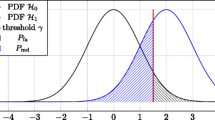Abstract
In this paper, stochastic resonance effect on the optimal detection under Neyman–Pearson (NP) criterion is investigated for a general nonlinear system. To this end, a noise enhanced detection optimization problem for maximizing the probability of detection under a constant constraint on the probability of false-alarm is formulated, where an additive noise is added to the nonlinear system input and the final decision is made based on the system output according to the NP criterion. Firstly, the noise modified NP decision rule is derived. Since one additive noise corresponds to one noise modified NP decision rule, the noise-modified NP decision rule can be viewed as a function of the additive noise. Then, the improvability of the optimal detection performance under NP criterion via the proposed noise-modified decision solution is simply discussed. The optimal additive noise is deduced as a random signal of no more than two constant vectors and the corresponding noise-modified NP decision rule is also determined. Finally, the performance comparisons between the original and the noise-modified optimal NP decision solutions for the sine transform system and the Amplitude limit system are made to illustrate the theoretical results.







Similar content being viewed by others
References
A.B. Akbay, S. Gezici, Noise benefits in joint detection and estimation problems. Signal Process. 118, 235–247 (2016)
K. Audhkhasi, O. Osoba, B. Kosko, Noise-enhanced convolutional neural networks. Neural Netw. 78, 15–23 (2016)
G.O. Balkan, S. Gezici, CRLB based optimal noise enhanced parameter estimation using quantized observations. IEEE Signal Process. Lett. 17(5), 477–480 (2010)
S. Bayram, S. Gezici, Noise enhanced M-ary composite hypothesis-testing in the presence of partial prior information. IEEE Trans. Signal Process. 59(3), 1292–1297 (2011)
S. Bayram, S. Gezici, H.V. Poor, Noise enhanced hypothesis-testing in the restricted Bayesian framework. IEEE Trans. Signal Process. 58(8), 3972–3989 (2010)
S. Bayrama, S. Gultekinb, S. Gezici, Noise enhanced hypothesis-testing according to restricted Neyman–Pearson criterion. Digit. Signal Process. 25, 17–27 (2014)
R. Benzi, A. Sutera, A. Vulpiani, The mechanism of stochastic resonance. J. Phys. A: Math. Gen. 14(11), L453–L457 (1981)
F. Chapeau-Blondeau, Quantum state discrimination and enhancement by noise. Phys. Let. A 378(30–31), 2128–2136 (2014)
F. Chapeau-Blondeau, D. Rousseau, Noise-enhanced performance for an optimal Bayesian estimator. IEEE Trans. Signal Process. 52(5), 1327–1334 (2004)
H. Chen, P.K. Varshney, J.H. Michels, Noise enhanced parameter estimation. IEEE Trans. Signal Process. 56(10), 5074–5081 (2008)
H. Chen, P.K. Varshney, S. Kay, J.H. Michels, Theory of the stochastic resonance effect in signal detection: part I—fixed detectors. IEEE Trans. Signal Process. 55(7), 3172–3184 (2007)
H. Chen, P.K. Varshney, S. Kay, J.H. Michels, Theory of the stochastic resonance effect in signal detection: part II—variable detectors. IEEE Trans. Signal Process. 56(10), 5031–5041 (2008)
F. Duan, F. Chapeau-Blondeau, D. Abbott, Noise-enhanced SNR gain in parallel array of bistable oscillators. Electron. Lett. 42(17), 1008–1009 (2006)
Z. Gingl, P. Makra, R. Vajtai, High signal-to-noise ratio gain by stochastic resonance in a double well. Fluctuat. Noise Lett. 1(3), L181–L188 (2001)
S. Kay, Can detectability be improved by adding noise? IEEE Signal Process. Lett. 7(1), 8–10 (2000)
S. Kay, J.H. Michels, H. Chen, K. Varshney, Reducing probability of descision error using stochastic Resonance. IEEE Signal Process. Lett. 13(11), 695–698 (2006)
L. Li, P. Shi, Y. Zhao et al., Containment control of multi-agent systems with uniform quantization. Circuits Syst. Signal Process. 38(9), 3952C3970 (2019)
S. Liu, T. Yang et al., Noise enhanced binary hypothesis-testing in a new framework. Digital Signal Process. 41, 22–31 (2015)
L. Lcken, O.V. Popovych, P.A. Tass, S. Yanchuk, Noise-enhanced coupling between two oscillators with long-term plasticity. Phys. Rev. E 93, 032210 (2016)
Patel, A., Kosko, B.: Mutual-information noise benefits in Brownian models of continuous and spiking neurons. In: International Joint Conference on Neural Network, pp. 1368–1375 (2006)
A. Patel, B. Kosko, Optimal noise benefits in Neyman-Pearson and inequality constrained signal detection. IEEE Trans. Signal Process. 57(5), 1655–1669 (2009)
A. Patel, B. Kosko, Optimal mean-square noise benefits in quantizer-array linear estimation. IEEE Signal Process. Lett. 17(12), 1005–1009 (2010)
M. Perc, Coherence resonance in a spatial prisoner’s dilemma game. New J. Phys. 8, 22 (2006)
M. Perc, Double resonance in cooperation induced by noise and network variation for an evolutionary prisoner’s dilemma. New J. Phys. 8(9), 183 (2006)
J. Pongfai, X. Su, H. Zhang et al., A novel optimal PID controller autotuning design based on the SLP algorithm. Expert Syst. 37(2), e12489 (2020)
D. Rousseau, G.V. Anand, F. Chapeau-Blondeau, Noise-enhanced nonlinear detector to improve signal detection in non-Gaussian noise. Signal Process. 86(11), 3456–3465 (2006)
D. Rousseau, F. Chapeau-Blondeau, Noise-improved Bayesian estimation with arrays of one-bit quantizers. IEEE Trans. Instrum. Meas. 56(6), 2658–2662 (2007)
T.A. Schonhoff, A.A. Giordano, Detection and estimation theory and its application (Prentice Hall, Upper Saddle River, 2006)
M. Wuehr, E. Nusser, S. Krafczyk et al., Noise-enhanced vestibular input improves dynamic walking stability in healthy subjects. Brain Stimul. 9(1), 109–116 (2016)
T. Yang, S. Liu et al., Noise benefits parameter estimation in LMMSE sense. Digital Signal Process. 73, 153–163 (2018)
T. Yang, S. Liu et al., Optimal noise enhanced signal detection in a unified framework. Entropy 18(6), 213 (2016)
Z. Yin, H. Song et al., Noise-enhanced chaos in a weakly coupled GaAs/(Al, Ga)As superlattice. Phys. Rev. E 95, 012218 (2017)
Acknowledgements
This work was supported by National Natural Science Foundation of China (Grant No. 61901067, 61903052), the Science and Technology Research Program of Chongqing Municipal Education Commission (Grant No. KJQN202000811, KJQN201900824, KJQN201900828), and the Scientific Research Project of Chongqing Technology and Business University in China (Grant Nos. 1956009, 1956011, 1952002). All data generated or analyzed during this study are included in this published article.
Author information
Authors and Affiliations
Corresponding author
Additional information
Publisher's Note
Springer Nature remains neutral with regard to jurisdictional claims in published maps and institutional affiliations.
Rights and permissions
About this article
Cite this article
Yang, T., Li, Y., Yang, S. et al. Stochastic Resonance Effect in Optimal Decision Solution Under Neyman–Pearson Criterion. Circuits Syst Signal Process 40, 3286–3304 (2021). https://doi.org/10.1007/s00034-020-01644-y
Received:
Revised:
Accepted:
Published:
Issue Date:
DOI: https://doi.org/10.1007/s00034-020-01644-y




